
views
Caring for Your Gums After a Tooth Extraction
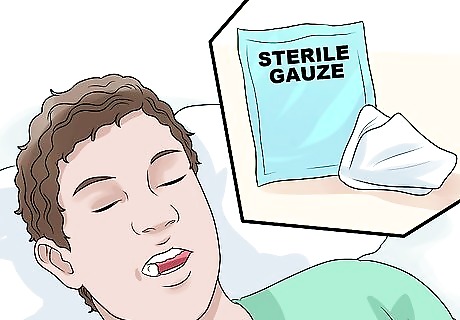
Bite tightly on the gauze. After a tooth extraction, your dentist will place a gauze on the wound to stop the bleeding. Make sure to bite down tightly on the gauze to apply pressure to the area to stop bleeding. If heavy bleeding continues, you may need to reposition the gauze pack to cover the wound more directly. Do not talk, as this may loosen the gauze and lead to further bleeding and delay the clot formation. If the gauze gets too wet, you may replace it with another; however, do not change gauze more often than necessary, and do not rinse out your mouth if you detect bleeding, as this may hinder clot formation. Do not disturb the extraction area by sipping through a straw; otherwise, your body isn’t able to form a blood clot. Avoid holding your hand over the area of extraction to avoid warming up the area. Remove the gauze after 30 to 45 minutes and check in the mirror to see if there is any bleeding.

Take medicine for the pain. Use only the medications prescribed by your dentist. If your oral surgeon has not provided you with a prescription for pain relievers, you may take an over-the-counter pain reliever. Take the antibiotics that your surgeon gives you. Take the first dose of pain medication as soon as possible before the effects of the anesthesia wear off. It’s best to complete the dosages of painkillers and antibiotics as prescribed.

Use an ice pack. Place an ice pack on your face outside the area of extraction. The ice pack reduces bleeding and controls swelling by constricting blood vessels. Use an ice pack for 10 minutes, then go without it for 5 minutes. Always wrap it in a towel or a cloth. Don’t place it directly on the skin. This can be done for the first 24 to 48 hours after extraction. After 48 hours, swelling should subside and ice will no longer provide relief. You can use a zipped plastic bag with crushed ice or ice cubes inside if you don’t have an ice pack. Avoid keeping your hand in the area of extraction as you will generate heat.
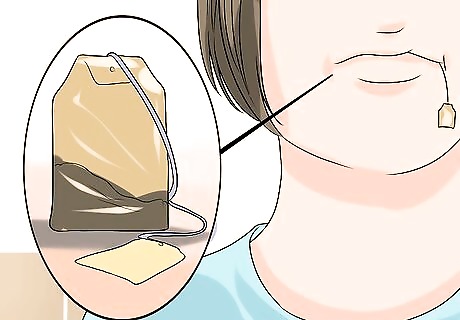
Use tea bags. Tea contains tannic acid, which helps blood clots form by contracting your blood vessels. Using a tea bag may help reduce bleeding. If you notice a small amount of bleeding an hour after extraction, place a moist tea bag on the extraction site and bite down tightly to apply pressure to the area. Do so for about 20 minutes.

Gargle with a warm saline rinse. Wait until the morning after extraction to rinse your mouth. You can prepare a warm saline rinse by mixing ½ tsp (3g) of salt into a glass of water. Gargle slowly and gently without creating any pressure. Just move your tongue from one cheek to the other several times, and then spit out the solution smoothly to avoid damaging the clot. Repeat rinsing with this solution 4 times a day for several days after the extraction, especially after meals and before bed.

Get plenty of rest. Proper rest ensures steady blood pressure, which helps facilitate blood clotting and healing of the gums. Do not engage in any physical activity for at least 24 hours after the extraction, and elevate the head slightly while resting to ensure that blood and/or saliva does not cause a choking hazard. Try sleeping propped up on two pillows and avoid sleeping on the extraction side so the blood doesn't stagnate under increased heat. Do not bend downwards nor do any heavy lifting. Always sit in an upright position.

Brush your teeth. After 24 hours, brush your teeth and tongue gently, but do not use the toothbrush near your extraction site. Instead, rinse gently using the saline solution described above to avoid damaging the clot. Follow this procedure for the next three to four days. Flossing and using mouthwash can be kept in your regular routine. Just be sure not to use the floss near extraction site. Use an antiseptic mouthwash or a rinse prescribed by your dentist to help kill bacteria and prevent any infection.

Use Chlorhexidine gel. This can be applied to the extraction area starting the next day after extraction for faster healing. It can also prevent bacteria from forming near the extraction site. This also helps reduce pain and discomfort. Do not apply the gel directly into the socket. Just apply the gel to the area around the extraction site.

Watch your diet. You'll want to wait until the anesthesia has completely worn off before attempting to eat food. Start with soft foods, chewing on the opposite side of your mouth as the extraction site. You may want to eat something cold and soft, like ice cream, to soothe the pain and provide you with some nourishment. Avoid anything hard, crunchy, crumbly, or hot, and do not use a straw, as this may dislodge a blood clot from your gums. Eat regularly and don’t skip meals. Eat food that is at room temperature or cold, but never warm or hot. Eat soft and mild-cold food like ice cream, smoothies, pudding, gelatin, yogurt, and soups. Make sure that what you eat isn’t too cold or hard, and that you don’t chew on the extraction area. Hard-to-chew foods (e.g. cereal, nuts, popcorn, etc.) can be painful and difficult to eat, and may injure the wound. Gradually change your food from liquids to semisolids to solids as the first few days pass. Avoid straws. Drinking with a straw creates suction pressure within the mouth, which may cause bleeding and prevent proper clotting, which can lead to dry sockets. Avoid spicy food, sticky food, hot drinks, caffeine products, alcohol, and carbonated drinks. Avoid tobacco/alcohol for at least 24 hours after extraction.
Understanding the Healing Process After a Tooth Extraction
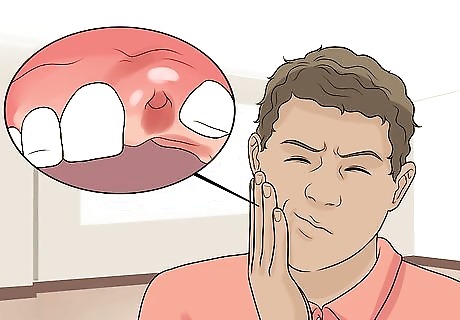
Expect swelling. Your gums and your mouth will swell as a response to the surgery, and you will probably be in pain. This is normal, and usually begins to subside after about two or three days. During that time, use an ice pack held against the affected cheek to soothe pain and reduce swelling and inflammation.
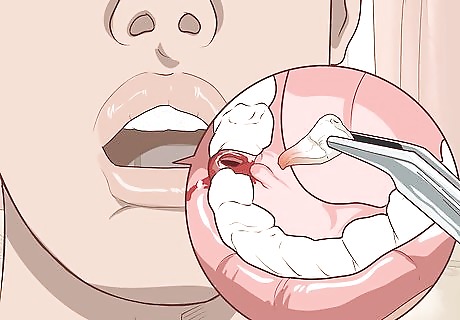
Expect bleeding. After a tooth extraction, there is a lot of bleeding from the tiny blood vessels within the gums and bone. Bleeding should never be extreme or excessive; however, in some cases your dentist may place sutures to help with the healing process. If this happens, it may mean that post-surgical packs are being placed between the teeth and not directly on the wound. Consult your surgeon and reposition/replace packs as necessary.
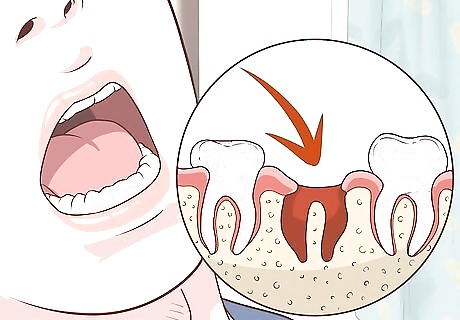
Don't disturb the clot. A clot will form within the first day or two, and it's extremely important not to disturb or remove it. Clotting is a necessary first step toward healing, and removing or disturbing the clot may prolong the healing process and lead to infection or pain.
Caring for Your Gums Before Going In for a Tooth Extraction

Inform your oral surgeon about any pre-existing conditions you may have. You should also inform your surgeon about any medications you are currently taking. These may complicate the surgical procedure and cause problems during or after surgery. Patients with diabetes generally take a longer time to heal after any dental treatment because bleeding also takes longer. Maintain a blood sugar level close to normal to ensure faster healing after an extraction, and inform your dentist about your diabetic condition and your recent glucose test results. Your dentist will decide whether or not your blood sugar level is adequately under control for an extraction procedure. Patients with high blood pressure should be aware that certain blood pressure medications may cause bleeding from the gums. This could cause complications if the medication is not ceased before a tooth extraction surgery. Inform your surgeon about any medications you are currently taking or have recently taken. Patients taking anticoagulants or blood-thinning drugs like warfarin and heparin should inform their surgeon about those medications before dental extractions, as this class of medication will hinder blood clotting. Patients taking oral contraceptives containing estrogen may have complications with blood clotting. Consult with your surgeon if you are currently taking an oral contraceptive. Some long-term medications will cause mouth dryness, which may lead to fungal infection. after tooth extraction. Consult with your surgeon before any procedure. You should also consult with your doctor before changing any medications or dosages that you are taking.

Understand that smoking may cause problems. Smoking is a known factor in the development of gum disease. In addition, the physical act of smoking may cause the dislodgement of blood clots, which are necessary for healing to take place in the gums. Tobacco may also irritate the sensitive wound and complicate the healing process. If you are currently a smoker, consider quitting before your tooth extraction. If you do not intend to quit smoking, be aware that patients should not smoke a cigarette for at least 24 hours after surgery. Patients who chew tobacco or "dip" should not use tobacco for at least seven days.
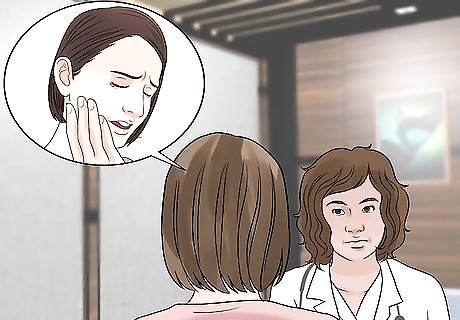
Consult with your primary physician. Letting your primary doctor know about the surgery before undergoing a tooth-extraction procedure may help avoid potential problems caused by medications you are taking or conditions you may have.

















Comments
0 comment